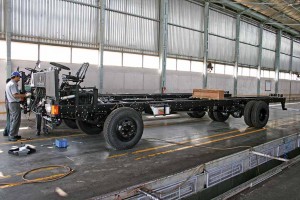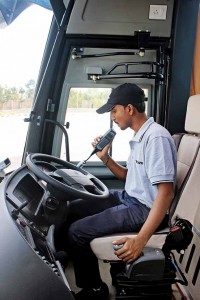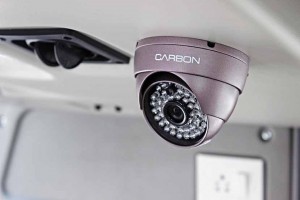Technology is elevating safety in commercial vehicles.
Team CV
The purchase of trucks and buses with fully built bodies is increasing. However, there still exists a market for those who build bodies on rolling truck and bus chassis in India. The implementation of Bus Code has defined the safety inclusions in bus bodies built by an OEM captive unit or by an independent bus body builder. In the case of trucks, the truck code is in the making. A sense of urgency prevails regarding the implementation of the truck code, but a time period for its implementation is yet to be defined. There is a talk of incorporating the learning of the Bus Code to ensure that it is effective, and serves the purpose. In the absence of a truck code, road side truck body builders exist in many parts of the country. They make use of wood, a commodity that is fast depleting, apart from iron and aluminium among others. Plastics hasn’t found a calling in the construction of truck bodies as yet. Its use, at best, is limited to purely cosmetic functions. Sensitive to fuel efficiency, the bus industry has been employing a good deal of plastics in the building of bus bodies at the other end. Their bearing on safety is a matter of debate, and much like the use of wood is in the building of truck bodies.
With companies like Daimler India Commercial Vehicles resorting to selling full-built trucks and buses only, the purchase of trucks with fully-built bodies is on the rise. Operators are coming to acknowledge the safety advantages of a fully-built truck body. The higher level of safety it offers in an unfortunate incident, like collision. However, cost advantages continues to lure them towards aftermarket truck body builders. A small percentage of the aftermarket truck body builders cater to the special application market. They build trucks that serve as chemical, oil and milk tankers; as flat bed car carriers; as airport application trucks; as municipal application trucks, and more. Safety in the case of each of these special application trucks differs, and is quite comprehensive. If safety is lacking, it is in the case of trucks with aftermarket cab and load body – especially the wooden bodies. In an unfortunate event of a collision or crash, the wooden cab or load body hardly serves to protect the occupants. It is a similar case with buses having aftermarket bodies built. With cost taking precedence, aftermarket bus bodies until the Bus Code came into play did not give much importance to safety, or the use of flame retardant material. Fire suppression systems in the engine compartment, and the provision for scientifically designed emergency exits are some of the provisions that the Bus Code has rightly ensured.
With the rule to equip trucks and buses above certain capacities, and of certain types with ABS is showing results. To curtail accidents caused by over speeding, state governments are claimed to ensure the fitment of speed governors. If the arrival of sleeper coach code and the airport tarmac coach has also contributed to elevate the safety of CVs, albeit buses, a big step ahead in elevating safety in the trucks and buses that ply in India is going to be a series of gadgets that will make the life of a driver easier and more productive. Wabco, which was at the fore front of arming Indian trucks and buses with ABS, is driving safety by piloting lane departure warning system. Expressed Jacques Esculier, Chairman & Chief Executive Officer, Wabco Inc., “We are introducing technologies and capabilities around advanced driver assistance systems like Autonomous Emergency Braking (AEB). In India, we are piloting lane departure warning systems. The air disc brakes we have designed may not be electronically driven, they are however essential for safety.” Seating systems specialist Harita Seating unveiled an Intelliseat it has developed in association with the Indian Institute of Technology, Madras. The seat, aimed at tractor and commercial vehicle drivers, is fitted with sensors that detect fatigue. When moderate fatigue is detected, a chime goes off. When the driver is close to dozing off, the seat vibrates, making a compelling reason for the driver to pull over. Volvo’s inter-city bus range for instance features a digital nose, fitted in the ceiling. It is claimed to detect any drop in oxygen level, and alerts the driver. A driver drowsiness assist feature is optional, and can detect a change in driver attention. An optional Alco-lock breath analyser prevents the bus from starting if the driver fails the breath test! On-board high-definition CCTV cameras and passenger alert systems are fast catching up.
With the arrival of electronics-based ABS, AEB, lane departure and drowsiness warning technologies to elevate safety, connected vehicles are getting closer to reality closer to reality. With telematics finding increasing number of takers in India, for tracking and tracing; for routing and re-routing; for geo fencing; for driver behaviour, and for preventive maintenance, connected trucks and buses are indeed closer to reality than many would think. Telematics is also turning into an efficient tool in commercial vehicle driver training. If it elevates safety of children travelling in a school bus, telematics is assisting truck and bus drivers in the period of difficulty to connect with their support system in case of an untoward incident, or when stranded due to some other reason. The Intelligent Transport Management System (iTraMS) from Bosch is an end-to-end Vehicle to Infrastructure (V2I) ecosystem, and includes an on-board unit (OBU), a strong IT backbone which comprises of web and mobile apps. hosted on enterprise cloud providing tools and processing data using advanced analytics for necessary decision making. The iTraMS web portal, mobile app. and on board unit (OBU) connect to the vehicle architecture and send back real-time alerts and reports about the vehicle health and driving behavior. Enabling seamless integration with ERP, iTraMS integrates monitoring sensors for humidity, etc., which can have an effect on the safe functioning of a truck.
Blind spots around a truck or a bus are often a reason for accident. Commercial vehicles (CVs) are longer and wider than passenger cars, making the blind spots much larger. To enhance safety and eliminate blind spots, Clarion has developed an overhead view monitor camera system that utilises image processing once the camera has been installed. Blind spot monitoring systems may take time to find their way to Indian commercial vehicles as it may prove tough to convince a fleet operator, or a truck owner to opt for one, and see value in it, the move up to BSIV has ensured that more electronics are finding their way into Indian commercial vehicles. They are opening up a world of new possibilities that elevate safety. Much to the surprise, safety technologies in commercial vehicles in India have progressed faster than in commercial vehicles in China. Said Esculier, “India has delivered on safety in trucks and buses faster.” He added, “ We have cameras that watch the driver, any time there is a safety event. This system has driven the number of events down significantly, making everyone safer.”





























